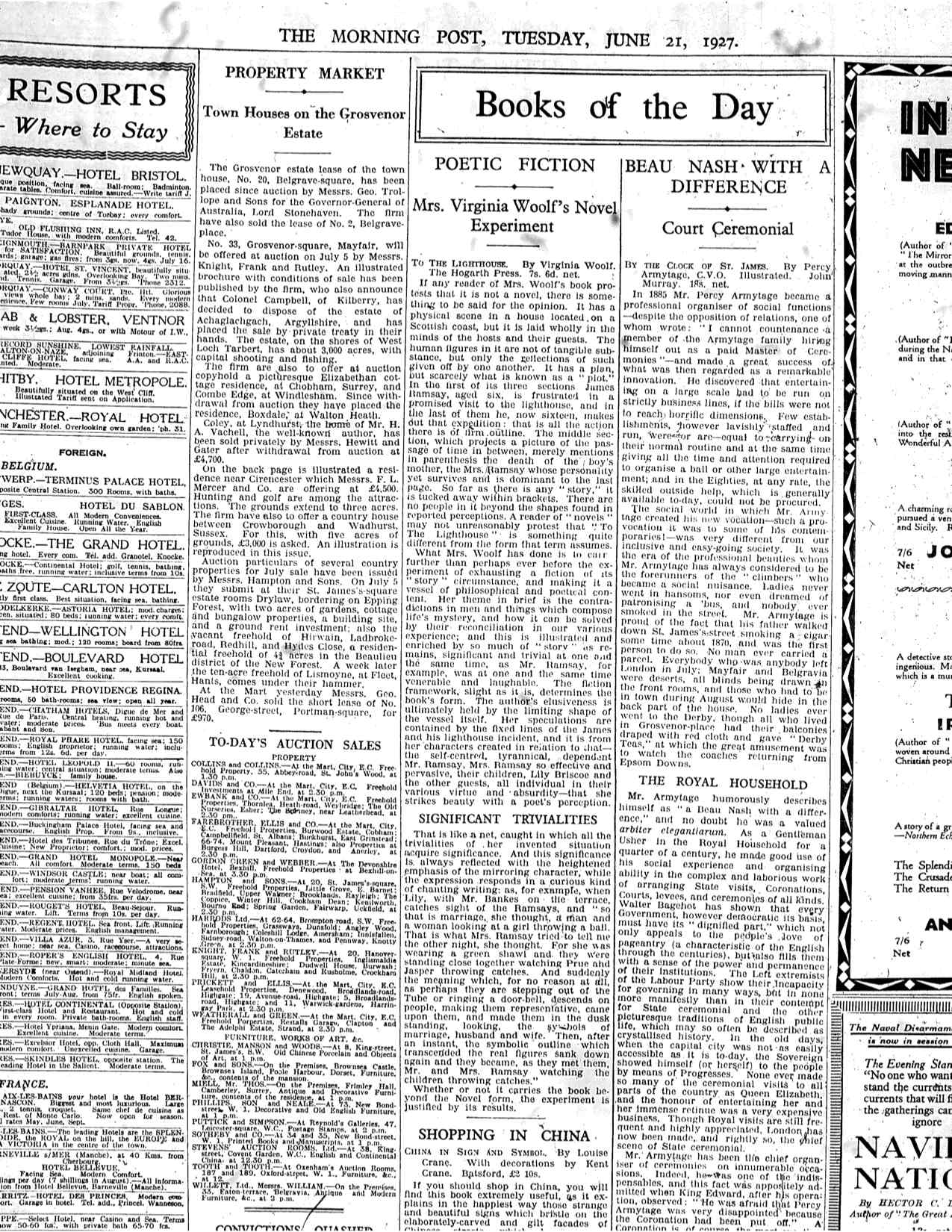
“Mrs. Woolf’s Novel Experiment.” The Morning Post. June 21, 1927, p.5.
POETIC FICTION
________
Mrs. Virginia Woolf’s Novel
Experiment
________
TO THE LIGHTHOUSE. By Virginia Woolf.
The Hogarth Press. 7s. 6d. net.
If any reader of Mrs. Woolf’s book protests
that it is not a novel, there is something
to be said for the opinion. It has a
physical scene in a house located on a
Scottish coast, but it is laid wholly in the
minds of the hosts and their guests. The
human figures in it are not of tangible substance,
but only the reflections of such
given off by one another. It has a plan,
but scarcely what is known as a “plot.”
In the first of its three sections James
Ramsay, aged six, is frustrated in a
promised visit to the lighthouse, and in
the last of them he, now sixteen, makes
out that expedition: that is all the action
there is of firm outline. The middle section,
which projects a picture of the passage
of time in between, merely mentions
in parenthesis the death of the boy’s
mother, the Mrs. Ramsay whose personality
yet survives and is dominant to the last
page. So far as there is any “story,” it
is tucked away within brackets. There are
no people in it beyond the shapes found in
reported perceptions. A reader of “novels”
may not unreasonably protest that “To
The Lighthouse” is something quite
different from the form that term assumes.
What Mrs. Woolf has done is to carry
further than perhaps ever before the experiment
of exhausting a fiction of its
“story” circumstance, and making it a
vessel of philosophical and poetical content.
Her theme in brief is the contradictions
in men and things which compose
life’s mystery, and how it can be solved
by their reconciliation in our various
experience; and this is illustrated and
enriched by so much of “story” as remains,
significant and trivial at one and
the same time, as Mr. Ramsay, for
example, was at one and the same time
venerable and laughable. The fiction
framework, slight as it is, determines the
book’s form. The author’s elusiveness is
ultimately held by the limiting shape of
the vessel itself. Her speculations are
contained by the fixed lines of the James
and his lighthouse incident, and it is from
her characters created in relation to that—
the self-centred, tyrannical, dependent
Mr. Ramsay, Mrs. Ramsay so effective and
pervasive, their children, Lily Briscoe and
the other guests, all individual in their
various virtue and absurdity—that she
strikes beauty with a poet’s perception.
SIGNIFICANT TRIVIALITIES
That is like a net, caught in which all the
trivialities of her invented situation
acquire significance. And this significance
is always reflected with the heightened
emphasis of the mirroring character, while
the expression responds in a curious kind
of chanting writing: as, for example, when
Lily, with Mr. Bankes on the terrace,
catches sight of the Ramsays, and “so
that is marriage, she thought, a man and
a woman looking at a girl throwing a ball.
That is what Mrs. Ramsay tried to tell me
the other night, she thought. For she was
wearing a green shawl and they were
standing close together watching Prue and
Jasper throwing catches. And suddenly
the meaning which, for no reason at all,
as perhaps they are stepping out of the
Tube or ringing a door-bell, descends on
people, making them representative, came
upon them, and made them in the dusk
standing, looking, the symbols of
marriage, husband and wife. Then, after
an instant, the symbolic outline which
transcended the real figures sank down
again and they became, as they met them,
Mr. and Mrs. Ramsay watching the
children throwing catches.”
Whether or not it carries the book beyond
the Novel form, the experiment is
justified by its results.






